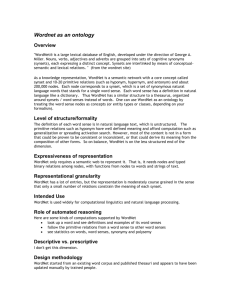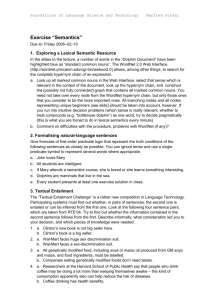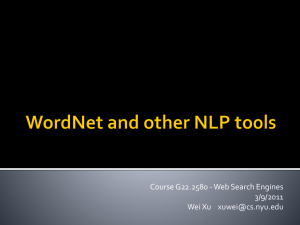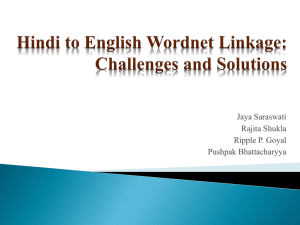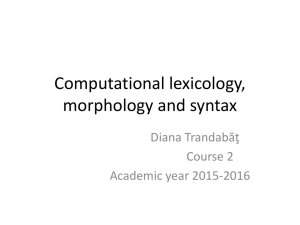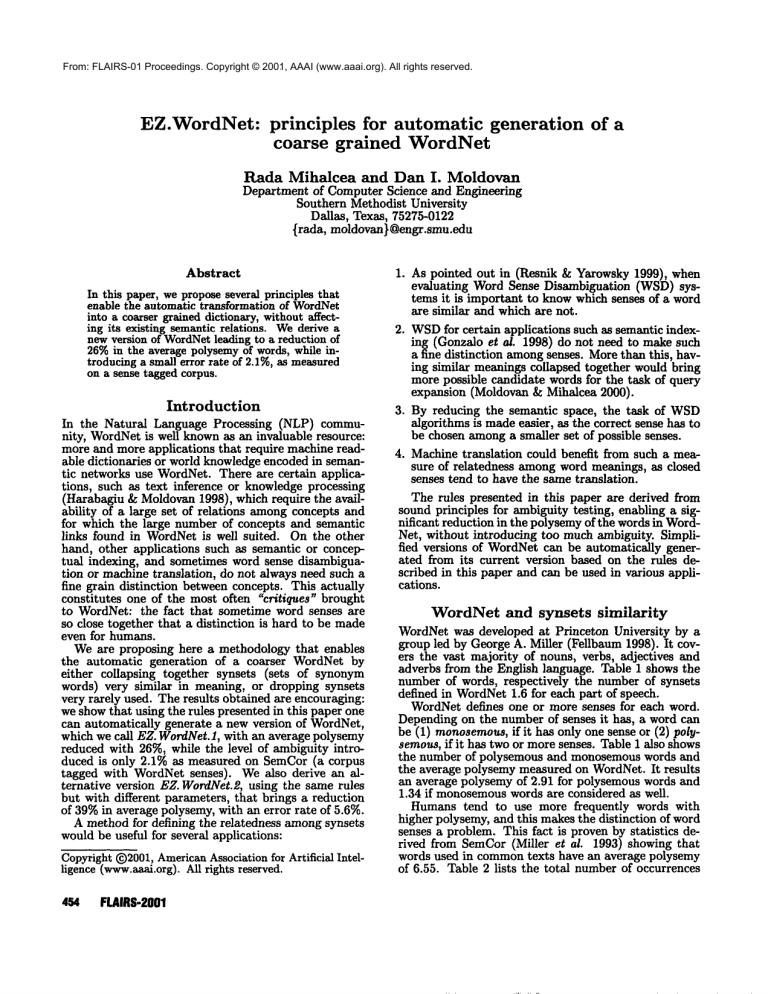
From: FLAIRS-01 Proceedings. Copyright © 2001, AAAI (www.aaai.org). All rights reserved.
EZ.WordNet: principles
for automatic generation
coarse grained WordNet
of a
Rada Mihalcea and Dan I. Moldovan
Department
of ComputerScienceand Engineering
SouthernMethodist
University
Dallas,
Texas,75275-0122
{rada,moldovan
) @engr.smu.edu
Abstract
In this paper, we propose several principles that
enable the automatic transformation of WordNet
into a coarser grained dictionary, without affecting its existing semantic relations. Wederive a
new version of WordNetleading to a reduction of
26%in the average polysemyof words, while introducing a small error rate of 2.1%, as measured
on a sense tagged corpus.
Introduction
In the Natural Language Processing (NLP) community, WordNetis well knownas an invaluable resource:
more and more applications that require machine readable dictionaries or world knowledgeencoded in semantic networks use WordNet. There are certain applications, such as text inference or knowledge processing
(Harabagiu & Moldovan1998), which require the availability of a large set of relations amongconcepts and
for which the large number of concepts and semantic
links found in WordNet is well suited. On the other
hand, other applications such as semantic or conceptual indexing, and sometimes word sense disambiguation or machine translation, do not always need such a
fine grain distinction between concepts. This actually
constitutes one of the most often "critiques" brought
to WordNet: the fact that sometime word senses are
so close together that a distinction is hard to be made
even for humans.
Weare proposing here a methodology that enables
the automatic generation of a coarser WordNet by
either collapsing together synsets (sets of synonym
words) very similar in meaning, or dropping synsets
very rarely used. The results obtained are encouraging:
we show that using the rules presented in this paper one
can automatically generate a new version of WordNet,
which we call EZ. WordNet.1, with an average polysemy
reduced with 26%, while the level of ambiguity introduced is only 2.1% as measured on SemCor (a corpus
tagged with WordNet senses). Wealso derive an alternative version EZ. WordNet.2, using the same rules
but with different parameters, that brings a reduction
of 39%in average polysemy, with an error rate of 5.6%.
A method for defining the relatedness amongsynsets
would be useful for several applications:
Copyright(~)2001, AmericanAssociationfor Artificial Intelligence (www.aaai.org).All rights reserved.
4S4
FLAIRS-2001
I. As pointedout in (Resnik& Yarowsky1999),when
evaluating
Word SenseDisambiguation
(WSD)systemsit is important
to knowwhichsensesof a word
aresimilar
andwhicharenot.
2. WSDforcertain
applications
suchas semantic
indexing (Gonzalo
et al.1998)do not needto makesuch
a finedistinction
amongsenses.
Morethanthis,havingsimilar
meanings
collapsed
together
wouldbring
morepossible
candidate
wordsforthetaskof query
expansion
(Moldovan
& Mihalcea
2000).
3. By reducingthe semanticspace,the taskof WSD
algorithms
is madeeasier,
as thecorrect
sensehasto
be chosen
amonga smaller
setof possible
senses.
4. Machine
translation
couldbenefit
fromsucha measureof relatedness
amongwordmeanings,
as closed
sensestendto havethesametranslation.
Therulespresented
in thispaperare derived
from
soundprinciples
forambiguity
testing,
enabling
a significant
reduction
inthepolysemy
of thewordsinWordNet,without
introducing
toomuchambiguity.
Simplifiedversions
of WordNet
can be automatically
generatedfromitscurrentversion
basedon therulesdescribed
in thispaperandcanbe usedin various
applications.
WordNet and synsets
similarity
WordNet was developed at Princeton University by a
group led by George A. Miller (FeUbaum1998). It covers the vast majority of nouns, verbs, adjectives and
adverbs from the English language. Table 1 shows the
number of words, respectively the number of synsets
defined in WordNet1.6 for each part of speech.
WordNet defines one or more senses for each word.
Depending on the number of senses it has, a word can
be (1) monosemous,if it has only one sense or (2) polysemous,
if ithastwoormoresenses.
TableI alsoshows
the numberof polysemous
and monosemous
wordsand
theaveragepolysemy
measured
on WordNet.
It results
an averagepolysemy
of 2.91for polysemous
wordsand
1.34if monosemous
wordsareconsidered
as well.
Humanstend to use more frequentlywordswith
higherpolysemy,
andthismakesthedistinction
of word
sensesa problem.
Thisfactis proven
by statistics
derivedfromSemCor(Milleret al. 1993)showingthat
wordsusedin commontextshavean averagepolysemy
of 6.55.Table2 liststhetotalnumberof occurrences
Monosemous Total senses II A~}g.polysemy Avg. polysemy
words
words
polys.wordsII
(- monos)
forms synsets senses
(-1- monos)
Noun
94473
66024
116318
12562
81911
34407
2.73
1.23
Verb
10318
12126
22067
4565
5753
16314
3.57
2.13
Adj
20169
17914
29882
5372
14797
15085
2.80
1.48
Adverb
4545
3574
5678
748
3797
1881
2.51
1.25
1.34
I TOTAL [129505 [ 99638 1173945 l[ 23247 I 106258 [ 67687 II
2.91
iPtofi word
iNu
berI iI Po,ysemo
speech
Table 1: Statistics on WordNet:number of word forms, number of synsets, number of monosemousand polysemous words,
average polysemy in WordNet1.6
of word forms in SemCor, and the number of senses
defined in WordNetfor these words forms.
Total senses H Average
Part of [ Total
speechI word occ. defined in WordNet polysemy
4.33
~oun
88398
382765
Verb
90080
944368
10.48
Adj
35770
157751
4.41
2.70
Adv
20595
55617
[ TOTAL [ 234843 ]
1540501
H 6.55
Table2: Statistics
on SemCor:
totalnumber
of wordoccurrences,
totalnumber
of senses
defined
in WordNet
and
average
polysemy
It results that in commontexts the average polysemy
of words with respect to WordNetis very high, and this
is whyWordNetis classified as a fine grained dictionary.
Similarity
measures in WordNet. A proof that
similarity amongsynsets is useful to be knownis constituted by the fact that there are already somesimilarity relations defined in WordNet.The problem is that
these relations are defined only for nouns and verbs,
and do not always succeed in indicating properly two
synsets as similar in meaning.
For verbs, a VERBGROUP
pointer is defined, pointing to synsets similar in meanings. For nouns, there
are three types of synset relations defined in WordNet:
(1) sisters, representing synsets with a word in common
and with the same direct hypernym; (2) cousins, which
are synsets with a word in commonand with at least
one pair of direct or indirect hypernymsrelated, based
on a predefined list (there is also a list of exception
synsets defined for this relation) and (3) twins, which
are synsets with three or more words in common.
These relations are intended to provide the user of
WordNet with a measure of similarity among the different senses of a word. There are no such relations
defined for adjectives and adverbs.
Several problems are associated with these relations:
(1) coverage of verb groups is incomplete (as mentioned in the WordNetmanuals); (2) the measures
noun synsets similarity are sometime too strong, and
sometime too loose; for example, these relations will
wrongly group together {house#3} with its meaning of
"a building in which something is sheltered or located"
and {house#5, theater, theatre} meaning "a building
where theatrical performances or motion-picture shows
can be presented", but they will fail to group as similar the synsets {decapitation#I, beaheading} defined
as. "execution by cutting off the victim’s head" and
~ aecapitation#2, beaheading} meaning "killing by cutting off the head".
The methods we are proposing are able to group similar synsets together based on set of rules derived from
sound principles. These methods can also be applied to
adjectives and adverbs.
Semantic
principles:
tests
for ambiguity
Whentalking about word meanings and ambiguity, one
of the problems is how to actually determine if a word
form is ambiguous or not. (Cruse 1986) describes three
principles used by humans in testing the ambiguity of
words. Wepresent them here and show how these principles can be translated into methods of measuring the
ambiguity level among the synsets in WordNet.
I. If there exists a synonym or one occurrence of a word form which is not
a synonym of a second, syntactically
identical occurrence of the same word
in a different context, then that word
form is ambiguous, and the two occurrences exemplify different senses.
The example given as an illustration of this principle is the word "match", which in the contexts "Gay
struck the match", respectively "The match was draw"
have two different synonyms, namely "lucifer" (or "~ction match") and "contest". It results that this word is
ambiguous in the two given contexts.
This principle can be reformulated in the following
way: if a word form, in two different contexts, has the
same synonyms, then that word form has similar meanings in the given contexts.
Translated in WordNetterminology, the context of a
word meaningis represented by its synset and its relations to other synsets. Wecan infer that if a word has
two senses with the same synonyms, then it is hard to
make the distinction among the two senses, and thus
we can collapse the appropriate synsets together. The
following rule is inferred:
PRINCIPLE
RuleSPI.IIf S1 andS2 aretwo synsets
containing
at leasttwowords,andif S1 and$2 contain
thesame
words,then$1 and$2 canbe collapsed
together
into
onesinglesynset
$12.
Example: Sense #1 and #3 for paper are:
S1 = {newspaper, paper} (a daily or weekly publication on folded sheets)
$3
= {newspaper, paper} ( a newspaper as a physical
object)
These two synsets can be collapsed together, as they
are very similar in meaning.
NATURAL
LANGUAGE
PROCESSING 455
There are cases when the synsets contain only one
single word, and thus we cannot directly apply this principle of measuring ambiguity among synsets. A good
approximation of the synonymy relation is represented
by the hypernymy links found in WordNet:if a particulax sense of a word has no synonyms, than its meaning
¯ can be judged by looking at its hypernym. Thus, another rule that can be inferred from principle I is:
Rule SP1.2
If S1 and $2 axe two synsets with the same hypernym,
and if $1 and $2 contain the same words, than S1 and
$2 can be collapsed together into one single synset
S12.
Example: Considersenses#I and #2 for the verb
eat:.
S1 - {eat) (take in solid food)
=~ { consume, ingest, take in, take, have)
$2 =
{eat} (eat a mea
0=~
{consume, ingest, take in, take, have)
These two senses axe fine distinctions of the possible
meanings of eat, and the two synsets $1 and $2 can
be collapsed together.
By relaxing this first principle in its requirement of
having all the synonymsof two different word meanings
identical in order to fuse the appropriate synsets, to a
requirement of having at least K identical synonyms,
we can infer Rule SP1.3. By taking K=3, we obtain
the twins similarity measure from WordNet.
Rule SPI.3If S1 and $2 are two synsetswithat
leastK wordsin common,then S1 and $2 can be
collapsed
together
intoonesingle
synset
$12.
Example Sense #I and #3 for noun teaching are:
$1 = {teaching, instruction, pedagogy} (the profession of a teacher)
$3 = { education, instruction, teaching, pedagogy, educational activity} (activities that impart knowledge)
PRINCIPLEII. If there ezists a word or expression
standing in a relation of oppositeness
to one occurrence of a word form,
which does not stand in the same relation to a second, syntactically identical
occurrence of the same word form in a
different confer, then that word form
is ambiguous, and the two occurrences
exempli~ different senses.
The example given for this ambiguity test is the word
"light", which is determined to be ambiguous in the
sentences "The room was painted in light colours", respectively "Arthur has a rather light teaching load", as
it has two different antonyms: "dark" and "heavy".
The reformulation of this principle is: if a word form,
in two different contexts, has the same antonyms, then
that word form has similar meanings in the given contexts. Wecan translate this in WordNet terms, and
measure the grade of similarity amongtwo synsets with
the following rule:
Rule SP2 If S1 and $2 are two synsets representing [
Itwo senses of a given word, and if S1 and $2 have
the same antonym, then $1 and $2 can be collapsed
together into one single synset $12.
4S6
FLAIRS-2001
Example: Senses#I and#2 fortheverbdress axe:
$1 = {dress, get dressed} (put on clothes)
antonym =~ {undress, disease, unease, unclothe,
strip, strip donna, disrobe)
$2 = {dress, clothe, enclothe, garb, raiment, tog,
garment, habilitate, fit out, apparel} (provide with
clothes or put clothes on)
antonym =~ {undress, disease, unease, unclothe,
strip, strip down, disrobe}
Finally, the last test of ambiguity refers to paxonymlc
relations 3 related to a particular word form.
PRINCIPLEIII. If there exists a word which stands
in a paronymic relation to one occurrence oy a word form, but does
not stand in the same relation to a
second, syntactically identical occurrence o] the same word form in a different context, then that word,form is
ambiguous, and the two occurrences
exemplify different senses.
This principle is illustrated using the noun "race". In
the sentence "The race was won by Arkle", this noun
has the verb "to race" related to it, while the same
noun in the sentence "They are a war-like race" has
two other related words, namely "racial" and "racist".
By having different paxonymically related words, the
noun "race" is determined to have different senses in
these two examples.
Reformulated, this principle becomes: if a word form,
in two different contexts, is paxonymicallyrelated to the
same words, than the word form has similar meanings
in the given contexts.
The translation into WordNetterminology cannot be
done for all parts of speech, as there axe no relations
defined in WordNetamong verbs and nouns, that would
help us determine paronymic relations of the form act
- actor. Still, this principle can be used for adjectives
and adverbs, where a pertainymy relation is defined.
The following rule is derived:
Rule SP3 If S1 and $2 axe two synsets representing I
two senses of a given word, and if $1 and $2 have[
the same pertainym, then $1 and $2 can be collapsed
together into one single synset S12.
Example: Senses #1 and #5 for the adverb lightly
are:
S1 = {lightly) (without good reason)
pertainym =~ {light#5} (psychologically light)
$5 = {lightly} (with indifference or without dejection)
pertainym =~ {light#5} (psychologically light)
Probabilistic
principles
Besides the principles presented in the previous section,
the polysemy of WordNet can be reduced based on the
frequency of senses and the probability of having paxticulax synsets used in a text. By dropping synsets with
very low probability of occurrence, we can reduce the
number of senses a word might have.
Weneed (1) a distribution of sense frequencies for the
different parts of speech and (2) a method of deriving
3Relations involving identity of the root, but different
syntactic categories (e.g. act - actor)
Part of [
speech]
Noun
Verb
1
78.52%
61.01%
80.98%
83.84%
Adj
Adv
]
2
12.73%
19.22%
12.35%
11.24%
]
Probability
~
4.40%
7.89%
3.96%
3.67%
]
4
2.07%
4.12%
1.41%
0.61%
of havin~ sense number
]
5
]
0.98%
2.64%
0.51%
0.42%
5
0.52%
1.47%
0.25%
0.15%
]
7
0.34%
0.98%
0.i6%
0.03%
I
8
]
>8
0.17%
0.65%
0.16%
0.009%
<0.1%
<0.5%
<0.05%
<0.009%
Table3: Statistics
on SemCor:
distribution
of sensesfornouns,verbs,adjectives
and adverbs
Part
of
speech
~F0
(s) [(w)
Noun
Verb
244
SFI.I
(s)
(w)
]
m
Adj
252
B
Adv
Noun
Verb
idj
Adv
244
252
B
m
349 743
117 242
115 244
23
52
349
117
115
23
743
242
244
52
Rule applied
SFI.2 [ 3PI.3
SF2
~F3
(s)
(w) [ (s)
(w) (s)
(w)
BZ. WordNet.J (K=3 Mazp=2)
216 216
100
328
2
3
131 131 71
226
7
7
9O
8
8
12
12
29
m
1
3
6
6
96
100
EZ. WordNet.~ (K=2 Mazp=5)
B
216 216 973 2015 2
3
B
131 131 677 1257 7
7
B
356
714
8
8
12
12
m
47
92
6
6
96
100
(s)
(w)
Totalreduced
word
senses
1074
889
931
84
1142
969
1018
85
2432
1827
1372
246
3159
1615
1628
158
3344
1767
5795
165
6321
3656
2773
418
FFI
Table4: Reductions
in the numberof synsets((s)columns)and in the numberof word senses((w) columns)
obtainedfor
eachrule.
the probability
of a synsetoccurring
in a text,starting
with the probabilities
of its component
words.
To determinethe distribution
of word sensefrequencies,we used againSemCor,as this is the only corpus
available
in which words are sense tagged using WordNet. Table 3 show these sense distributions
for nouns,
verbs, adjectives and adverbs.
Let us denote a synset with S = { Wil, W~, ... ,
Wi, }, meaning that the synset is composed by words
having senses il, i2 ... , i,. If we denote with Pih the
probability of occurrence of a word having sense ik, then
the probability of occurrence Ps for the synset S is equal
with the summation of the probabilities
of occurrence
X"k=" p.
for the componentwords,i.e. Ps = z.,k=,
,~.
In orderto reducethe granularity
of WordNetwithout introducingtoo much ambiguity,we use this formula togetherwith probabilities
derivedfrom SemCor,
and drop thosesynsetswith a probability
of occurrence
Ps smallerthan a given threshold.The followingrule
is derived:
Rule PPI If S is a synsetS = { Wix, Wi, ... , Wi, }
k----n
with the probability
of occurrence Ps = ~-~k=l
P/h
< Maxp than S can be consideredas a very rarefy
occurringsynsetand it can be dropped.
Example:
The noun synset
S = { draft#ll,
[
draught#5, drawing#6} (the act of moving a load by[
drawing or pulling) has the probability of occurrence I
Ps =
I Pll + Ps + P6 = 0.1% + 0.98% + 0.52%
= 1.6%. For Maxp set to 2.0, this synset can be]
dropped.
[
Note that this way of computing the probability
of a
synset does not make reference to the component words
themselves, but to their senses, and thus we do not have
to deal with the problem of data sparseness that would
result from the limited size of the corpus.
Applying
the principles
on WordNet
We applied these semantic and probabilistic
principles
on WordNet and generated
two new versions,
called
EZ. WordNet.1 and EZ. WordNet.2.
The semantic principles resulted in collapsed synsets,
while the probabilistic
principles
determined which
synsets can be dropped. By applying these rules, we
obtain a reduction in the number of synsets,
and implicitly
a reduction in the number of word senses.
There are two variables used by the reduction rules,
namely the K minimum number of common synonyms
among two synsets,
as required
by Rule SP1.3, and
Maxp, which is the maximum probability
threshold
for
the Rule PP1. Depending on the values chosen for these
parameters, one can obtain sense inventories closer to
the original WordNet, but with a smaller reduction in
polysemy, or versions of WordNet with a higher reduction in polysemy but with more synsets modified respect to WordNet.
We chose two sets of values for these variables,
and
consequently we obtained two versions of WordNet:
¯ EZ. WordNet.1, for K = 3 and Mazp = 2.
¯ EZ. WordNet.2, for K = 2 and Maxp = 5.
Table 4 shows, for each of these versions, the reduction obtained in number of synsets, respectively
in the
number of senses, for each of the semantic and probabilistic rules. Rule SPO is applicable only for verbs and
it corresponds to the VERBROUPpointers already defined in WordNet. Combining the information
derived
from this table with the statistics
shown in Table 1, we
can calculate
the averagepolysemyfor the two new versionsof WordNet.Table5 showsthe totalsensesfor the
polysemouswords, as computedin EZ. WordNet.1and
EZ. WordNet.2,as well as the averagepolysemycomputedfor thesesenseinventories.
A much more importantand interestingresultwould
be to measurethe reduction
in the numberof sensesfor
NATURAL
LANGUAGE
PROCESSING4S7
Part of
speech
Noun
Verb
Adj
Adv
[TOTAL
Polysemous
words
12562
4565
5372
748
I 23247
Monosemous
words
81911
5753
14797
3797
I 106258
"lbtal senses Avg.polys.
polys.words (-monos)
31975
2.54
14487
3.17
13713
2.55
1635
2.18
II
61810
I 2.65
Avg.polys. ’lbtal senses Avg.polys. Avg.polys.
(+monos)
polys.words (-monos)
(+monos)
1.20
28086
2.23
1.16
1.96
12658
2.77
1.78
1.41
12312
2.29
1.34
1.19
1463
1.95
1.15
I 1.29
II
54429
I 2.34
I 1.24
[
Table 5: Statistics on EZ.WordNet.1and EZ.WordNet.2: number of senses for polysemous words, average polysemy for
polysemouswords only and for all words
Part of Total
word
[[ Total
WordNetAvg.[][~
speech occurrencesH senses
polys. [[
Noun
88398
382765
4.33
Verb
944368 10A8
90080
Adj
35770
157751
4.41
Adv
20595
55617
2.70
[TOTALI 234843 II 1540501 I 6.55 II
Total
senses
316796
668712
119044
45928
11504801
EZ.WordNet.1
EZ. WordNet.~
]
Avg. Missing Krror [[ Total [ Avg. Missing
polys, senses
rate [[ senses [ polys, senses
3.58
1461
1.65% 256178 2.89
4668
7.42
2879
3.1% 542629 6.02
6310
3.32
545
1.52% 101907 2.84
1366
2.23
200
0.97% 39732
1.92
818
4.89 I 5085 12.16% II 940446 I 4.0 I 13162 [
l~rror [
rate [
5.28%
7.0%
3.81%
3.97%
5.6% [
Table 6: Averagepolysemyand error rate obtained on SemCorfor EZ. WordNet.1and EZ. WordNet.~. Wealso replicate,
comparison purposes, the total numberof senses and average polysemyin WordNet,as shownin Table 2
the words commonlyused by people, i.e. to determine
the reduction in the polysemy of the words in SemCor.
Wecan also make use of this corpus to determine the
ambiguity introduced by the new sense inventories with
respect to the original WordNetsense tagging.
We compute two measures on SemCor: (1) the average polysemy determined as the total number of senses
for the words in SemCor,with respect to EZ. WordNet1
or 2, divided by the total numberof words, as it results
from Table 2; and (2) error rate, defined as the total
number of words from SemCorthat are not defined anymore in the new WordNetversions, divided by the total
number of words in SemCor. Table 6 shows these figures computed for EZ. WordNet.1 and EZ. WordNet.2.
Interpretation
of results. Looking at both Table 1
and 5, it can be seen that the rules proposed in this
paper enable an average reduction in the number of
senses for polysemous words of 9% for EZ. WordNet.1,
respectively 20%for EZ. WordNet.~, with respect to the
original WordNet.
There is a difference between the polysemy of the
words in a dictionary and the polysemy of the words
actually used by humans (the words in the active vocabulary). This difference is clearly shown by Table
2, where one can see that the average polysemy of the
words in a commontext like SemCor is much higher
than the average polysemy of the words in a dictionary.
Hence, a more representative result is obtained by
comparing the average polysemies obtained with different sense inventories on a corpus, such as SemCor.
Wecan also determine the error rate introduced by the
usage of the new sense inventories.
From Table 6, it results a reduction of 26%in polysemy, with an error rate of 2.16%. The second version
has a larger error rate, namely 5.6%, but it also brings
a larger reduction of 39%in polysemy. The error rates
of 2.1%and 5.6% are acceptable as it is considered that
the accuracy obtained by humansin sense tagging is not
larger than 92-94%. Depending on the application, one
458 FLAIRS-2001
for
of these versions or newly compiled versions of WordNet
can be used.
Conclusions
One of the main problems associated with WordNet
is its fine granularity. In this paper, we present a
methodology for reducing the average polysemy of the
words defined in WordNet. Wederive a set of semantic
and probabilistic rules that are used to either collapse
synsets very similar in meaning, or drop synsets that
are very rarely used. In this way, we obtain a new version of WordNetleading to a reduction of 26%in the
average polysemy of words, while introducing a small
error rate of 2.1%, as measured on SemCor. An alternative version is also derived, that brings a polysemy
reduction of 39%with an error rate of 5.6%. These results are encouraging, as a coarse grained WordNetis
knownto be beneficial for a large range of applications.
References
Cruse, D. 1986. Lezical Semantics. CambridgeUniv. Press.
Fellbaum, C. 1998. WordNet, An Electronic Lazical
Databaae. The MITPress.
Gonzalo,J.; Verdejo,F.; Chugur,I.; and Cigarran, J. 1998.
Indexing with WordNetsynsets can improvetext retrieval.
In Proceedings of COLING-ACL
’98 Workshop on Usage
of WordNetin Natural LanguageProcessing Systems.
Harabagiu, S., and Moldovan,D. 1998. KnowledgeProcessing on an Eztended WordNet. The MITPress. 289-405.
Miller, G.; Leacock, C.; Randee, T.; and Bunker, R. 1993.
A semantic concordance. In Proceedings of the 3rd DARPA
Workshop on HumanLanguage Technology, 303-308.
Moldovan, D., and Mihalcea, R. 2000. Using WordNet
and lexical operators to improveInternet searches. IEEE
Internet Computing4(1):34-43.
Resnik, P., and Yarowsky,D. 1999. Distinguishing systems and distinguishing senses: new evaluation methods
for word sense disambiguation. Natural LanguageEngineering 5(2):113-134.

